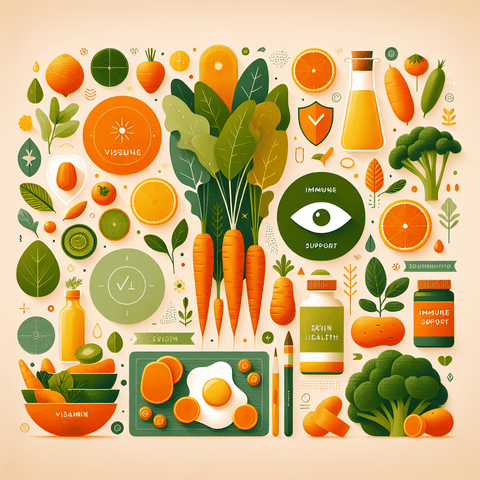Introduction
Vitamin A is a fat-soluble nutrient essential to numerous physiological processes including vision, immune function, reproduction, and cellular communication. While it's commonly associated with eye health, vitamin A also plays a crucial role in maintaining healthy skin and mucous membranes, promoting proper lung function, and supporting growth and development. With a wide array of dietary and supplemental sources, choosing the right form of vitamin A can be a challenging yet important decision for individuals seeking to maintain optimal health.
Not all vitamin A options are created equal. Different forms—such as retinol, retinyl esters, and beta-carotene—vary in their origin, bioavailability, and functionality in the human body. Depending on your health needs, dietary restrictions, lifestyle, and age, one type of vitamin A may be more beneficial than another. Additionally, overuse or misuse of certain types of vitamin A can pose health risks, such as toxicity or nutrient imbalances.
This article will serve as a comprehensive guide to the various forms of vitamin A available from both natural and supplemental sources. You'll learn about their benefits, risks, and ideal use cases, helping you make an informed choice about which type of vitamin A is best suited for your individual needs. Whether you're interested in boosting immune response, strengthening vision, or supporting skin health, we'll provide evidence-based insights and tips to help you navigate this vital nutrient.
Understanding Vitamin A in Nutritional Supplements
Vitamin A exists in two major forms: preformed vitamin A, which includes retinol and retinyl esters found in animal-based foods or supplements, and provitamin A carotenoids, like beta-carotene, found in plant foods. In supplements, these forms offer variable levels of bioactivity, absorption rates, and potential side effects. The form you choose can directly influence how effectively your body utilizes the nutrient and whether it meets your unique physiological requirements.
One of vitamin A’s most essential functions is supporting vision, particularly under low-light conditions. In the retina, vitamin A combines with the protein opsin to form rhodopsin, a molecule fundamental to the phototransduction process of converting light into electrical signals. Vitamin A is also integral to immune system performance, helping to maintain the structural and functional integrity of the skin and mucous membranes—the body's first line of defense against pathogens.
Cellular growth and differentiation—key components of fetal development and tissue repair—require adequate vitamin A intake. It's also necessary for gene expression, reproductive processes, and red blood cell production. Each of these roles highlights the importance of incorporating this vitamin either through diet or supplements. Supplement labels may not always clearly distinguish between the forms, underscoring the need to understand ingredient lists and dosages to ensure you're picking the most suitable option.
Bioavailability—the measure of how efficiently a substance is absorbed and utilized in the body—is a critical determinant in the effectiveness of vitamin A supplements. Preformed retinol offers higher bioavailability but also carries a greater risk of toxicity, particularly when consumed in excess. On the other hand, beta-carotene, as a provitamin A, poses a far lower risk of toxicity because the body regulates its conversion to active vitamin A based on how much is needed.
When choosing a vitamin A supplement, consider products that are rigorously tested for potency, purity, and safety. Supplements offered through platforms like Topvitamine.com often feature third-party certification to help ensure trustworthy quality. The decision between beta-carotene and retinol ultimately depends on individual health goals and physiological factors, which we'll explore further in the sections below.
Retinol: The Active Form of Vitamin A in Supplements and Its Benefits
Retinol is the most bioactive form of vitamin A and is directly usable by the body without requiring enzymatic conversion. Found predominantly in animal sources such as liver, fish oil, dairy products, and egg yolks, retinol is often used in dietary supplements for its fast-acting effects on vision, immune support, cellular repair, and skin health.
Supplementing with retinol is particularly beneficial for individuals with diagnosed vitamin A deficiencies, such as those suffering from liver disorders, fat malabsorption syndromes, or those on extremely low-fat diets. Retinol-based supplements are also used therapeutically for skin-related conditions like acne and psoriasis, often under medical guidance. Their high efficacy in correcting deficiency states makes them a go-to remedy in clinical settings, and as such, they are routinely included in high-potency formulations.
However, since retinol is preformed vitamin A, it is also associated with a risk of hypervitaminosis A when chronically consumed in high doses. Over-supplementation can lead to a range of adverse effects, including liver damage, bone demineralization, headaches, and even birth defects during pregnancy. For this reason, it is crucial to adhere strictly to dosage guidelines—typically not exceeding the tolerable upper intake level of 3,000 mcg (10,000 IU) per day for adults without medical supervision.
To safely include retinol in your supplement regimen, opt for products that offer moderate doses, especially if you’re already obtaining vitamin A through your diet. Additionally, look for formulations that utilize emulsified or micellized forms of retinol, which can enhance absorption while minimizing gastrointestinal side effects. Brands available on Topvitamine.com often meet such criteria and cater to various needs, including high-absorption softgels and synergistic blends with vitamin D and K2 to improve nutrient interplay.
Keep in mind that retinol is fat-soluble, so it's best taken with a meal containing healthy fats to promote absorption. Individuals with specific conditions or those who are pregnant should consult with healthcare providers before initiating retinol supplementation, as autogenous conversion control mechanisms do not apply to preformed vitamin A. When used appropriately, retinol is a potent and fast-acting tool in the nutritional arsenal for combating deficiency and promoting overall health.
Beta-Carotene Sources: The Plant-Based Vitamin A Precursors and Their Role in Nutrition
Beta-carotene is a carotenoid—a pigment found in plants—that serves as a provitamin A, meaning it needs to be converted into the active form inside the body. Unlike retinol, beta-carotene must undergo enzymatic cleavage in the intestinal mucosa to form retinal, which can then be converted to the physiologically useful form retinoic acid or retinol based on bodily needs. This regulated conversion process significantly reduces the risk of vitamin A toxicity, making beta-carotene a safer alternative for long-term supplementation.
Dietary sources rich in beta-carotene include vibrant orange, yellow, and dark green vegetables and fruits. Carrots, sweet potatoes, spinach, kale, butternut squash, and apricots are notable examples. These foods don’t just supply provitamin A—they also contribute fiber, phytochemicals, and a spectrum of vitamins and minerals important for overall health. For individuals adhering to plant-based or vegetarian diets, beta-carotene is the preferred and sometimes exclusive way to attain vitamin A.
In supplement form, beta-carotene is derived either from synthetic sources or natural algae like Dunaliella salina. Products featuring natural beta-carotene tend to offer a full spectrum of mixed carotenoids, which may provide additional antioxidant benefits. Beta-carotene is not only used for eye health and immune function but also valued for its antioxidant properties, helping to neutralize free radicals and potentially reducing oxidative stress as part of a balanced lifestyle.
A distinct advantage of beta-carotene lies in its non-toxic profile even when consumed in higher amounts. The body limits its conversion based on retinol stores, preventing accumulation and toxicity. However, individuals with certain genetic variations or poor conversion capacity—due to hypothyroidism, liver dysfunction, or digestive issues—may not optimally benefit from beta-carotene alone, making a mixed-source supplement more suitable for such populations.
While whole-food intake is the best way to obtain beta-carotene, supplements can fill dietary gaps or support specific conditions. Always choose a supplement free from unnecessary additives and verified for quality. For instance, options available at Topvitamine.com offer access to both isolated and blended formulations of carotenoids, in dosages suitable for daily maintenance or therapeutic use as directed by a healthcare provider.
Vitamin A Supplements: How to Choose the Right Product for Your Needs
Selecting the ideal vitamin A supplement requires careful consideration of several personal factors, including age, sex, health status, dietary habits, and any existing medical conditions. Supplement types generally fall into three categories: preformed vitamin A (retinol, retinyl palmitate), provitamin A (beta-carotene), and combination formulas containing both. Each has particular advantages and considerations, so aligning your choice with your individual needs is crucial.
For individuals at risk of, or diagnosed with, vitamin A deficiency, a retinol-based supplement may be recommended under medical supervision. Pregnant women, however, should exercise caution, as excessive retinol intake can result in fetal abnormalities. In these cases, beta-carotene offers a safer alternative. Meanwhile, vegetarians and vegans—less likely to consume significant preformed vitamin A from diet—may benefit from beta-carotene-rich supplements or fortified foods.
One of the core principles to follow when selecting a supplement is ensuring product quality. Look for third-party testing, certification of Good Manufacturing Practices (GMP), and ingredient transparency. Supplements featured at Topvitamine.com are screened for potency and purity, offering a vetted selection for discerning consumers. These platforms also provide access to multivitamin formulas that combine vitamin A with synergistic nutrients like vitamin D, K2, and magnesium for comprehensive support.
Understanding supplement labels is another vital element in making an informed decision. Labels may denote vitamin A content in IU (international units) or micrograms (mcg) of retinol activity equivalents (RAE), with 1 mcg RAE equivalent to about 3.3 IU of retinol or 12 mcg of beta-carotene from food. This is important when comparing products and staying within recommended daily intake limits—900 mcg RAE for adult men and 700 mcg for adult women, according to the European Food Safety Authority (EFSA).
A population-specific approach is also advised. Older adults may require higher maintenance doses due to decreased nutrient absorption, while those with liver or gastrointestinal issues may need easily absorbable forms like emulsified retinol. Consulting a qualified healthcare practitioner is essential before initiating a new regimen, especially when using high-dose supplements for therapeutic purposes.
Natural Vitamin A: Obtaining Vitamin A Through Whole Foods and Whole-Body Approaches
While supplements can effectively address nutrient deficiencies, obtaining vitamin A from natural food sources remains the gold standard for most people. Whole foods provide the necessary cofactors—enzymes, lipids, and fiber—that enhance nutrient utilization and balance in the body. Animal-based sources such as liver, cod liver oil, egg yolks, and full-fat dairy products provide retinol, while colorful fruits and vegetables deliver beta-carotene and other carotenoids that the body can convert into vitamin A as needed.
One of the chief benefits of natural vitamin A intake from foods is improved safety. Whole-foods-based consumables pose virtually no risk of vitamin A toxicity—a concern associated with the overuse of high-dose preformed vitamin A supplements. Moreover, consuming vitamin A in the context of a well-balanced meal enhances its fat-dependent absorption, delivering more consistent and efficient bioavailability compared to isolated supplements taken on an empty stomach.
Incorporating vitamin A-rich foods into your diet can support not just eye and immune health but also skin rejuvenation and bone development. For individuals who follow plant-based diets or have dietary restrictions limiting animal products, an emphasis on leafy greens, orange vegetables, and fortified plant-based milks can provide adequate intake when consumed thoughtfully.
Synergistic nutrients also play a critical role in optimizing vitamin A storage and utilization. Vitamins C, D, E, and K all interact with vitamin A in various metabolic pathways. For example, vitamin D supports immune regulation, while vitamin K contributes to calcium metabolism and reduces the risk of arterial calcification. Quality multivitamin formulations available at Topvitamine.com often include complementary nutrients to support holistic health goals.
A whole-body approach to vitamin A not only ensures sufficient intake from diverse sources but also aligns with broader wellness objectives. Integrating healthy fats, avoiding processed foods that deplete nutrients, and engaging in regular physical activity can enhance nutrient metabolism and storage, ensuring that your body makes the most out of the food you eat.
... (continues with remaining sections in the same detail and formatting) ...


